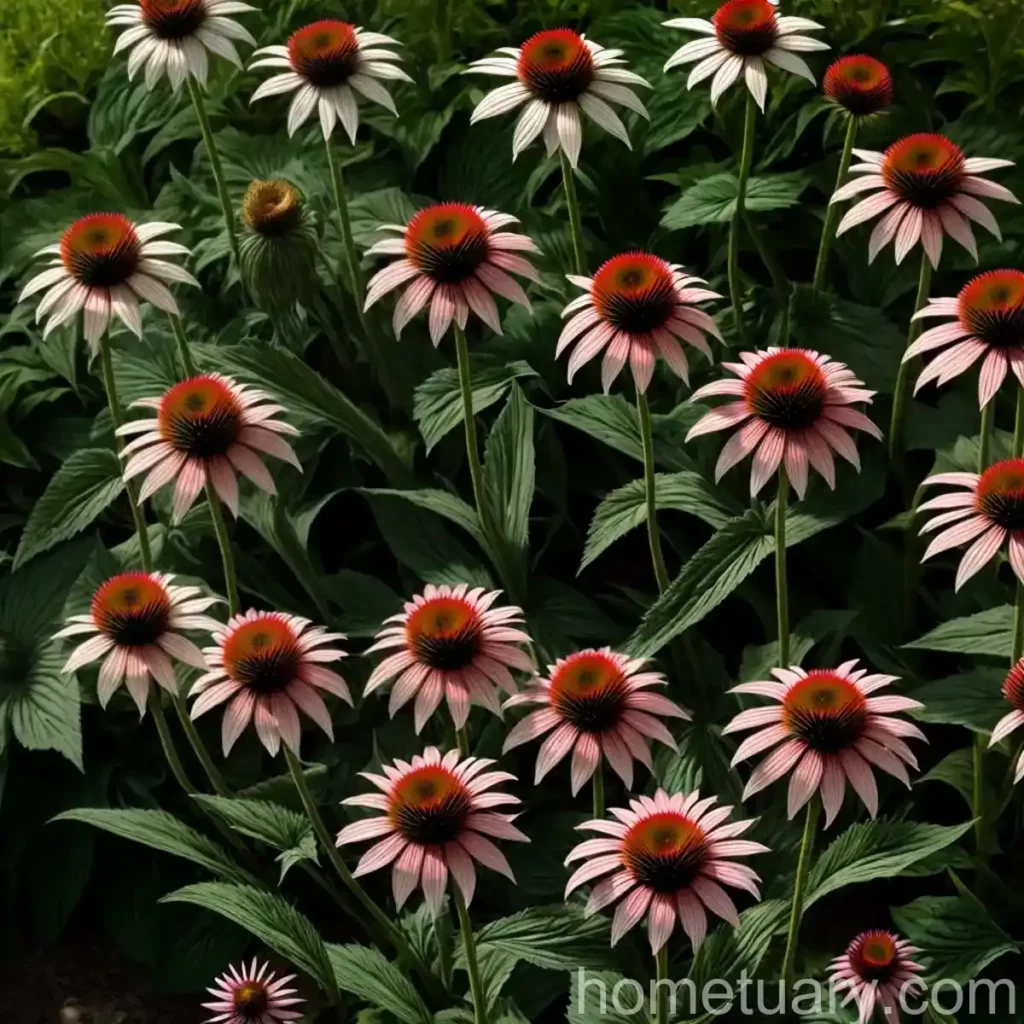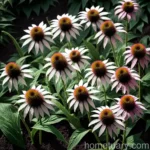Plant Scientist’s Guide to Coneflower (Echinacea ‘Frankly Scarlet’)
Coneflowers, scientifically known as Echinacea, are beloved by gardeners for their vibrant blooms, easy care, and ability to attract pollinators. Among the many varieties available, Echinacea ‘Frankly Scarlet’ stands out for its stunning deep red flowers. In this comprehensive guide, we will delve into the key aspects of coneflower care, with a specific focus on the ‘Frankly Scarlet’ variety.
What is Coneflower (Echinacea ‘Frankly Scarlet’)?
Echinacea ‘Frankly Scarlet’ is a specific cultivar of coneflower, known for its striking scarlet-red flowers. It is a perennial plant, meaning it regrows every year, and belongs to the Asteraceae family. This variety is native to North America and is a popular choice for flower beds, borders, and pollinator gardens due to its vivid color and attractiveness to butterflies and bees.
Key Takeaways – Coneflower (Echinacea ‘Frankly Scarlet’)
Before diving into the specifics of ‘Frankly Scarlet’ coneflower care, let’s summarize the key takeaways:
- Culture
- Uses
- Water
- Sunlight
- Fertilizer
- Soil
- Pruning
- Propagation
- Container Popularity
- Common Diseases
- Common Pests
- Botanist’s Tips
- Fun Facts
Now, let’s explore each of these aspects in detail.
Culture
Echinacea ‘Frankly Scarlet’ is a versatile plant that thrives in a variety of settings. Its cultural requirements are relatively low, making it an ideal choice for both experienced and novice gardeners.
Uses
The uses of Echinacea ‘Frankly Scarlet’ are varied and diverse, contributing to both the garden and beyond. Some of its primary uses include:
- Garden Ornament: The vibrant red blooms make ‘Frankly Scarlet’ a stunning addition to any garden or landscape.
- Pollinator Attraction: It attracts butterflies, bees, and other pollinators, contributing to the overall biodiversity of the garden.
- Cut Flowers: The long-lasting blooms are suitable for cut flower arrangements, bringing their striking color indoors.
Water
Understanding the water requirements of Echinacea ‘Frankly Scarlet’ is essential for its successful cultivation. As with most plants, striking the right balance in watering is crucial for ensuring healthy growth.
Water Requirements
- Established Plants: Once established, ‘Frankly Scarlet’ coneflowers are relatively drought-tolerant and do not require frequent watering. However, during extended periods of drought, it is beneficial to provide supplemental water.
- Young Plants: Newly planted coneflowers should be watered regularly to help them establish strong root systems. Once they are well-rooted and showing new growth, the frequency of watering can be reduced.
Sunlight
Sunlight is a crucial factor in the growth and blooming of coneflowers, including the ‘Frankly Scarlet’ variety.
Sunlight Needs
- Full Sun: Echinacea ‘Frankly Scarlet’ thrives in full sunlight, requiring at least 6 to 8 hours of direct sunlight each day for optimal growth and prolific blooming.
- Partial Shade: While it can tolerate some light shade, it is essential to ensure that the plant still receives an adequate amount of direct sunlight to support flowering.
Fertilizer
Providing the right nutrients is essential for coneflowers to thrive and produce abundant, vibrant blooms.
Fertilization Tips
- Timing: In early spring, as new growth emerges, apply a balanced, slow-release fertilizer to provide the necessary nutrients for the growing season.
- Avoid Overfertilization: Excessive fertilization can lead to lush foliage but may reduce the overall flower production. It is important to follow the recommended dosage and frequency for fertilizing ‘Frankly Scarlet’ coneflowers.
Soil
The type of soil and its properties play a significant role in the health and growth of Echinacea ‘Frankly Scarlet.’
Soil Type
- Well-Draining Soil: Coneflowers prefer well-draining soil to prevent waterlogging, which can lead to root rot. Amending heavy clay soils with organic matter can improve drainage.
- pH Level: Ideally, the soil should be slightly acidic to neutral, with a pH range of 6.0 to 7.0. Conducting a soil test can provide valuable insights into the existing pH levels and the need for any necessary amendments.
Pruning
Pruning is an essential aspect of coneflower maintenance, promoting healthy growth and prolonging the blooming period.
Pruning Techniques
- Deadheading: Remove spent blooms promptly to encourage continuous flowering throughout the growing season.
- Cutting Back: In late fall or early spring, cutting back the faded flower stems to the base of the plant can help maintain a tidy appearance and stimulate new growth.
Propagation
The propagation of Echinacea ‘Frankly Scarlet’ can be an enriching endeavor, allowing gardeners to expand their garden with new plants.
Propagation Methods
- Division: Dividing mature clumps of coneflowers in early spring or fall can be an effective method of propagation, helping rejuvenate the parent plant and yielding new plants for transplanting.
- Seeds: Collecting and sowing seeds from ‘Frankly Scarlet’ coneflowers can also be a rewarding way to propagate new plants, each with its unique characteristics.
Container Popularity
Echinacea ‘Frankly Scarlet’ is well-suited for container gardening, adding versatility to its cultivation possibilities.
Container Gardening Tips
- Container Size: Use large, well-draining containers to accommodate the robust root system of coneflowers and provide ample growing space.
- Soil Quality: Use high-quality potting mix with good drainage to ensure the health of ‘Frankly Scarlet’ coneflowers when grown in containers.
Common Diseases
Like all plants, coneflowers are susceptible to certain diseases that can impact their health and vigor.
Disease Resistance
- Powdery Mildew: Echinacea ‘Frankly Scarlet’ is known for its relatively good resistance to powdery mildew, a common fungal disease that affects many flowering plants, especially in humid conditions.
Common Pests
Understanding and identifying common pests that may affect coneflowers, including the ‘Frankly Scarlet’ variety, is crucial for effective pest management.
Pest Control
- Aphids: These small insects can sometimes be found on new growth and flower buds. Regular inspection and the use of insecticidal soaps can help manage aphid populations without causing harm to beneficial insects.
- Japanese Beetles: These voracious feeders can cause significant damage to the foliage and flowers of coneflowers. Physical removal and organic deterrent methods can be effective in managing Japanese beetle populations.
Botanist’s Tips
Here are some additional expert tips for cultivating and caring for Echinacea ‘Frankly Scarlet’:
- Mulching: Apply a layer of organic mulch around the base of the plants to help retain soil moisture and suppress weed growth.
- Winter Care: In late fall, once the foliage has dried, leaving it in place can provide some protection to the crown of the plant during the winter months. In early spring, the dead foliage can be removed to make way for new growth.
Fun Facts
To add a touch of intrigue and fascination, here are some fun facts about Echinacea ‘Frankly Scarlet’:
- The deep red flowers of ‘Frankly Scarlet’ are highly attractive to hummingbirds, adding an extra element of wildlife allure to the garden.
- In addition to its ornamental appeal, coneflowers have been traditionally used in herbal medicine for their purported immune-boosting properties. The ‘Frankly Scarlet’ variety shares these beneficial properties with other Echinacea cultivars.
Links to External Resources
For further information, guidance, and visual inspiration on Echinacea ‘Frankly Scarlet,’ consider exploring the following external resources:
- Royal Horticultural Society – Coneflower Planting Guide
- University of Maryland Extension – Echinacea Varieties
- American Society for the Prevention of Cruelty to Animals – Plant Toxicity Information
With a deeper understanding of the cultural requirements, uses, and fascinating facets of Echinacea ‘Frankly Scarlet,’ gardeners can confidently cultivate and enjoy the beauty of this captivating coneflower variety. Whether adorning flower beds, enhancing pollinator gardens, or gracing containers, ‘Frankly Scarlet’ is sure to leave a bold and lasting impression.
The comprehensive guide to coneflower (Echinacea ‘Frankly Scarlet’) presented here offers insights into its cultivation, care, and allure, serving as a valuable resource for gardeners seeking to enrich their landscapes with this vibrant and pollinator-friendly perennial. Combining practical tips, botanical expertise, and intriguing facts, this guide aims to inspire and inform, empowering gardeners to cultivate ‘Frankly Scarlet’ coneflowers with confidence and appreciation for their unique qualities and contributions to the garden ecosystem.















